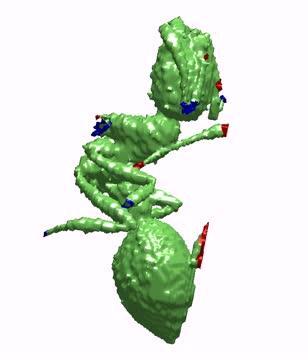Three years ago, Georgia Institute of Technology researchers took a close look at a connectivity phenomenon - how fire ants work together to build waterproof rafts to stay alive.
After examining the edges and tops of rafts, they discovered that ants grip each other with their mandibles and legs at a force of 400 times their body weight. Next they did what anyone would do.
They froze them.
A miniature CT scan machine helped them to look at the strongest part of the structure – the inside – to discover how opaque ants connect, arrange and orient themselves with each other.
"Now we can see how every brick is connected," said Georgia Tech Assistant Professor David Hu. "It's kind of like looking inside a warehouse and seeing the scaffolding and I-beams."
They found a lot of beams.
On average, each ant in a raft connects to 4.8 neighbors. Ants have six legs, but using their claws, adhesive pads and mandibles, each critter averages nearly 14 connections. Large ants can have up to 21. Out of the 440 ants scanned, 99 percent of them had all of their legs attached to their neighbors. The connectivity produces enough strength to keep rafts intact despite the pull of rough currents.

The incoming and outgoing connections for a fire ant. Credit: Georgia Institute of Technology
Hu and his team also noticed that the insects use their legs to extend the distances between their neighbors.
"Increasing the distance keeps the raft porous and buoyant, allowing the structure to stay afloat and bounce back to the surface when strong river currents submerge it," said Nathan Mlot, a Georgia Tech graduate student in the George W. Woodruff School of Mechanical Engineering who worked on both studies.
Mlot and the rest of the research team also found that smaller ants tend to fill in the spaces around large ants. This keeps water from seeping in and prevents weak spots in the raft. The insects, large and small, arrange perpendicularly rather than parallel. This adds to the adaptability of the raft, allowing it to expand and contract based on the conditions. The same is true when ants build towers and bridges for safety and survivability.
Citation: Foster, P. C., Mlot, N. J., Lin, A. and Hu, D. L. (2014). Fire ants actively control spacing and orientation within self-assemblages. J. Exp. Biol. 217, 2089-2100. Source: Georgia Institute of Technology




Comments